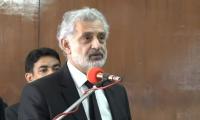The writer, a Chevening scholar, studied International Journalism at the University of Sussex.
The busting of India’s information warfare by EU DisinfoLab has caught much of the world unawares. The voluminous report on how the sophisticated ecosystem of disinformation has operated since 2005 is nothing short of a bombshell. However, there is little element of surprise in the clandestine operations for those who have keenly observed the conduct of New Delhi’s foreign policy in pursuit of its regional ambitions.
What is actually breathtaking in the whole episode is the sheer scale of the covert operations and the impunity with which they have been allowed during the last 15 years. The disinformation infrastructure is underpinned by fake local newspapers, fake think tanks, fake NGOs, as well as a leading Indian newswire service ANI to promote and project Indian interests and discredit Pakistan globally.
According to the investigation, the Srivastava Group, whose foundation almost coincided with that of the United Nations Human Rights Council (UNHRC), led and coordinated the activities at the apex of the superstructure. The various parts of the disinformation ecosystem fed off one another by sharing news analysis, op-eds and contents to enhance their impact and widen outreach.
The network particularly targeted the EU and the UN. As put by the BBC report, it followed a two-pronged strategy: in Geneva, the think tanks and NGOs leveraged their contacts and lobbied in favor of India by using the platforms of the UNHRC at the behest of the UN-accredited organizations. It reached out to members of the European Parliament (MEPs) to write “exclusive opinion pieces” that were then republished on the fake websites.
Readers may recall how a 27-member group of the EU parliamentarians mostly belonging to far-right parties was taken on a stage-managed tour of Indian-Occupied Kashmir in the wake of mounting criticism of human rights abuses following the illegal and immoral annexation of Jammu & Kashmir. The same group of MEPs also met Indian PM Modi in what was a much-needed photo-op to shore up his sagging credentials.
There are several aspects of the revelations that call for closer examination and scrutiny.
To begin with, though the researchers did add a note of caution that their findings may not necessarily be attributable to the Indian government, the sheer scale of the covert operations and the manner of their sophistication has RAW’s footprints written all over. The fact that they were exclusively aimed at discrediting Pakistan and China, chief rival countries with which India is in active conflict, leaves nothing in doubt about the identity of the sponsors of this smear campaign.
Systems have wholly gone digital in the developed world, particularly in the EU and the US. Indian operatives breached the digital defence of the European Union to capitalize on the goodwill that exists for New Delhi, thanks to its huge market and diplomatic clout. However, in doing so it did raise a fundamental question about the right to information. This right, sacrosanct and inviolable as it is generally held to be, loses its meaning if the sources of the information being churned out remain questionable.
The spread of fake news essentially deprives consumers of their universally sanctioned right to access and articulate information freely and without being maneuvered by the vested interests. The idea here was to manufacture consent and impose the uniformity of opinion on people without their knowledge.
The DisinfoLab researchers noted how ANI was used to repackage at least 13 anti-Pakistan and anti-China opinion pieces written by MEPs that were originally published in the ‘EU Chronicle’, a fake newspaper. The purpose behind relaying information published in ‘foreign outlets’ through ANI, one of the largest wire services with a wide broadcast presence, was to deflect the increasing attention from the stinging criticism of Modi’s reprehensible actions at home by providing “endorsement” of his leadership.
The reimagining of India by the saffron-clad BJP government has left the cracks within the Indian polity wide open and Modi knows that the only way to bridge the fault lines and feed the monster of Hindu nationalism is to feed it with anti-Pakistan rhetoric. The disinformation network facilitated Modi in domesticating his violence-prone, deeply divisive populist agenda.
While one may be tempted to dismiss the revelations as the work of propaganda, the fact remains that the systematic and organized disinformation campaign sought to influence policy within the EU and UN systems. There was clearly a method to the madness in ‘wooing’ the third-parties for their endorsement to win greater legitimacy and support for particular positions at international forums. And it was done in a manner that even those used in the sinister campaign may not be exactly aware of the designs of its sponsors.
The damning revelations by EU DisinfoLab have painted India in a bad light globally and taken the veneer of being the largest democracy off its face. This research has also highlighted that, no matter how robust a diplomatic machinery India may have and the huge economic incentives it may be capable of offering to the world, it is still constrained to hide the ugly reality brewing in its midst.
Modi’s mission of refashioning India in the image of the Hindutva ideology has repercussions that will outlive him and whose effects will continue to reverberate for a long time to come. The renewed vigor shown by the Modi government in undermining Pakistan speaks to the internal decay he has unleashed in India.
The tweet of Kaushik Basu, former World Bank’s chief economist that “India’s growth has collapsed from over +10% in 2010 to around -10% in 2020” points to the emerging reality of Modi’s India. He was, however, quick to add that it is not just the failure of the economic policy but also the dwindling trust in society spurred by increasing divisiveness in a multi-ethnic country. The massive ongoing protests by farmers and trade unions reveal how fault lines are widening the chasm between the BJP establishment and the people at large.
The expose of a huge Indian propaganda machine highlights that the theatre of war is fast shifting and is now becoming increasingly dependent on the expertise and skill set of public information professionals. The era of cyber warfare has come full circle, needing fresh thinking of strategy and investment to empower the government’s information system in light of the contemporary challenges.
How we respond to such a concerted anti-Pakistan campaign should be carefully deliberated upon and a whole-of-the-government approach may be employed to cater to the information warfare unleashed by India.
Pakistan did well to comprehensively document Indian-sponsored terrorism activities in a dossier and share it with the UN and other key world capitals. However, it should be a work-in-progress aimed at exposing Indian designs that threaten to imperil peace and stability in South Asia.
Email: amanatchpk@gmail.com
Twitter: @Amanat222
A representational image showing residents walking at a wholesale market in Karachi. — AFP/FileOnce again there is...
A representational image showing late Pakistani human rights activist and Supreme Court lawyer Asma Jahangir. —...
A representational image showing a security personnel sanding guard beside a ship carrying containers at Gwadar port....
A health worker administers polio vaccine drops to a child during a door-to-door polio vaccination campaign in Lahore,...
Armed militants of the banned Tehreek-e-Taliban Pakistan pose for a photograph in Orakzai Agency. —...
An aeroplane of the national flag carrier of Pakistan is seen in this file photo. — AFPWhile Pakistan considers...







